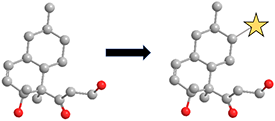
Human cells, including neurons, are phenomenally complex. At any give point in time, tens of thousands of interactions between different molecules are taking place. Trying to identify how one molecule (say a neurotrophic small molecule) behaves in a cell is analogous to trying to isolate a single conversation in the midst of a city-wide festival.
In order to help in that endeavor, we attach added "pieces" to the neurotrophic molecule that can act as a reporter and help us identify what the molecule interacts with. This is a long-used technique in biochemistry, but in order to use this technique we need to synthetically create the modified molecule. Hence traditional organic chemistry is used to enable biochemical investigation.


Precision in a Crowd
Reporter tags help identify the neurotrophic molecule and all things it interacts with.
Mechanistic Probe
In the Williams lab, we are developing new ways to make these modified mechanistic probes. We are using hydroxyl groups (the most ubiquitous functionality in natural product molecules) to direct the introduction of an amine group. This amine is a modifiable point of attachment. It allows for any reporter to be connected to the molecule of interest in a mild fashion.
